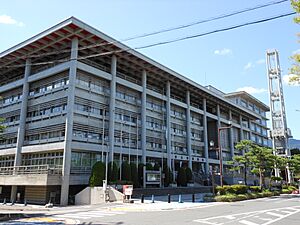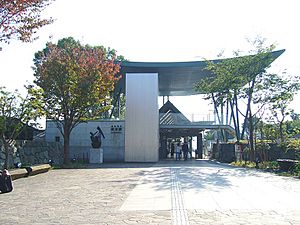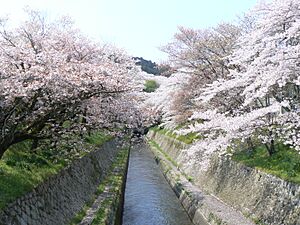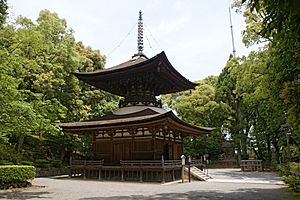Ōtsu facts for kids
Quick facts for kids
Ōtsu
大津市
|
|||||||||||||
|---|---|---|---|---|---|---|---|---|---|---|---|---|---|
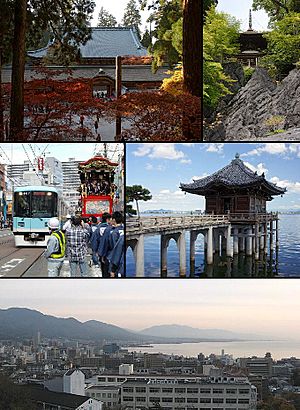
Enryaku-ji, Ishiyama-dera
Otsu Festival and the tram, Mangetsu-ji Ukimido City view and Lake Biwa |
|||||||||||||
|
|||||||||||||

Location of Ōtsu in Shiga Prefecture
|
|||||||||||||
| Country | |||||||||||||
| Region | Kansai | ||||||||||||
| Prefecture | Shiga | ||||||||||||
| Area | |||||||||||||
| • Total | 464.51 km2 (179.35 sq mi) | ||||||||||||
| Population
(October 1, 2021)
|
|||||||||||||
| • Total | 343,991 | ||||||||||||
| • Density | 740.546/km2 (1,918.005/sq mi) | ||||||||||||
| Time zone | UTC+09:00 (JST) | ||||||||||||
| City hall address | 3-1 Goryō-chō, Ōtsu-shi, Shiga-ken 520-8575 | ||||||||||||
| Climate | Cfa | ||||||||||||
|
|||||||||||||
| Ōtsu | |||||||
|---|---|---|---|---|---|---|---|

Ōtsu in kanji
|
|||||||
| Japanese name | |||||||
| Kanji | 大津 | ||||||
| Hiragana | おおつ | ||||||
| Katakana | オオツ | ||||||
|
|||||||
Ōtsu (大津市, Ōtsu-shi) is the capital city of Shiga Prefecture in Japan. As of October 2021, about 343,991 people live here. The city covers an area of about 464.51 square kilometers (179.35 sq mi). Ōtsu is known for its beautiful location on the shores of Lake Biwa, Japan's largest lake.
Contents
History of Ōtsu
Ōtsu has a very long history, going back to the Yayoi period (around 300 BC to 300 AD). It was an important place for travel and trade by water on Lake Biwa. It was also a key stop on major land routes like the Tōkaidō and Nakasendō highways. These roads connected Japan's eastern provinces to its ancient capitals.
Ōtsu as an Ancient Capital
From 667 to 672, Ōtsu was actually the capital of Japan! Emperor Tenji built the Ōmi Ōtsu Palace here. After a war called the Jinshin War, the city was briefly renamed Furutsu, meaning "old port".
Later, in 794, a new capital called Heian-kyō (which is now Kyoto) was built nearby. Ōtsu then became an important satellite town and a major traffic point for the new capital. Its original name, Ōtsu, meaning "big port," was brought back.
Ōtsu in the Edo Period
During the Edo period (1603-1868), Ōtsu continued to thrive. It was a busy port on Lake Biwa and a major shukuba (post station) on the Tōkaidō and Nakasendō highways. The city was directly controlled by the Tokugawa shogunate because of its important location for travel and trade.
Modern Changes in Ōtsu
After the Meiji Restoration in 1868, Japan's government changed. Ōtsu Prefecture was created in 1868, and then it became part of Shiga Prefecture in 1872. Ōtsu was chosen as the capital of Shiga. The town of Ōtsu officially became a city on October 1, 1898.
The Ōtsu Incident
On May 11, 1891, an event known as the Ōtsu incident happened here. Tsarevich Nicholas Alexandrovich of Russia (who later became Tsar Nicholas II) was visiting. An escort policeman attacked him. Nicholas survived, but the event caused a big problem between Japan and Russia.
Lake Biwa Canal
In the 1890s, the Lake Biwa Canal was built. This canal connected Ōtsu to Kyoto and was about 8.7 kilometers (5.4 miles) long. It helped with water and passenger transportation. It also provided electricity for Japan's first streetcar railways. This canal is now recognized as a Historic Site.
Over the years, Ōtsu grew by merging with nearby towns and villages. The town of Shiga merged into Ōtsu on March 20, 2006.
Population Growth
The number of people living in Ōtsu has steadily increased over the last 100 years.
| Historical population | ||
|---|---|---|
| Year | Pop. | ±% |
| 1920 | 85,759 | — |
| 1930 | 105,585 | +23.1% |
| 1940 | 117,697 | +11.5% |
| 1950 | 144,626 | +22.9% |
| 1960 | 155,114 | +7.3% |
| 1970 | 181,164 | +16.8% |
| 1980 | 228,982 | +26.4% |
| 1990 | 277,290 | +21.1% |
| 2000 | 309,793 | +11.7% |
| 2010 | 337,634 | +9.0% |
| 2020 | 345,070 | +2.2% |
| Source: [1] | ||
Geography of Ōtsu
Ōtsu is located on the southern and western shores of Lake Biwa. This is Japan's largest lake. The city stretches along the lake in an L-shape. It includes busy areas near the lake and less populated hills and mountains to the west and south. Mount Hiei is to the west and forms part of the border with Kyoto.
Neighboring Cities and Towns
Ōtsu shares borders with several other places:
- In Shiga Prefecture: Kusatsu, Rittō, Kōka, Takashima
- In Kyoto Prefecture: Kyoto, Uji, Ujitawara
Climate in Ōtsu
Ōtsu has a Humid subtropical climate. This means it has warm summers and cool winters. There is usually light or no snowfall. The average temperature in Ōtsu is about 13.8°C (56.8°F). The city gets about 1430 mm (56 inches) of rain each year, with September being the wetest month. August is the warmest month, averaging around 25.8°C (78.4°F), and January is the coldest, at about 2.3°C (36.1°F).
| Climate data for Otsu (1991−2020 normals, extremes 1977−present) | |||||||||||||
|---|---|---|---|---|---|---|---|---|---|---|---|---|---|
| Month | Jan | Feb | Mar | Apr | May | Jun | Jul | Aug | Sep | Oct | Nov | Dec | Year |
| Record high °C (°F) | 16.5 (61.7) |
20.3 (68.5) |
24.0 (75.2) |
28.8 (83.8) |
33.2 (91.8) |
36.1 (97.0) |
38.4 (101.1) |
38.5 (101.3) |
37.5 (99.5) |
31.7 (89.1) |
26.6 (79.9) |
20.0 (68.0) |
38.5 (101.3) |
| Mean daily maximum °C (°F) | 7.9 (46.2) |
8.5 (47.3) |
12.6 (54.7) |
18.6 (65.5) |
23.7 (74.7) |
26.8 (80.2) |
30.9 (87.6) |
32.5 (90.5) |
28.1 (82.6) |
22.2 (72.0) |
16.1 (61.0) |
10.5 (50.9) |
19.9 (67.8) |
| Daily mean °C (°F) | 4.1 (39.4) |
4.4 (39.9) |
7.6 (45.7) |
13.1 (55.6) |
18.2 (64.8) |
22.1 (71.8) |
26.2 (79.2) |
27.3 (81.1) |
23.3 (73.9) |
17.4 (63.3) |
11.5 (52.7) |
6.5 (43.7) |
15.1 (59.2) |
| Mean daily minimum °C (°F) | 0.7 (33.3) |
0.6 (33.1) |
3.2 (37.8) |
8.0 (46.4) |
13.3 (55.9) |
18.2 (64.8) |
22.6 (72.7) |
23.5 (74.3) |
19.6 (67.3) |
13.3 (55.9) |
7.3 (45.1) |
2.8 (37.0) |
11.1 (52.0) |
| Record low °C (°F) | −5.4 (22.3) |
−6.6 (20.1) |
−2.7 (27.1) |
−0.4 (31.3) |
3.4 (38.1) |
8.6 (47.5) |
15.1 (59.2) |
16.5 (61.7) |
9.9 (49.8) |
3.4 (38.1) |
0.2 (32.4) |
−4.1 (24.6) |
−6.6 (20.1) |
| Average precipitation mm (inches) | 56.8 (2.24) |
69.7 (2.74) |
117.9 (4.64) |
125.6 (4.94) |
156.9 (6.18) |
217.7 (8.57) |
211.8 (8.34) |
159.5 (6.28) |
172.0 (6.77) |
149.1 (5.87) |
79.3 (3.12) |
60.2 (2.37) |
1,566.6 (61.68) |
| Average precipitation days (≥ 1.0 mm) | 7.2 | 7.9 | 10.6 | 10.4 | 10.3 | 12.4 | 12.0 | 9.1 | 10.7 | 9.2 | 7.0 | 7.5 | 114.6 |
| Mean monthly sunshine hours | 120.4 | 125.4 | 160.9 | 183.0 | 192.8 | 142.1 | 159.3 | 202.9 | 150.2 | 157.1 | 141.1 | 133.1 | 1,870.2 |
| Source: Japan Meteorological Agency | |||||||||||||
Economy and Products
Ōtsu has a history of making unique products. These include:
- Ōtsu-e: A type of folk drawing that travelers bought during the Edo period.
- Ōtsu soroban: An abacus (a counting tool) that was widely used in Japan.
- Zeze-yaki and Konan-yaki: Types of ceramics made during the Edo period.
- Zeze-cha: The first Japanese tea ever sent to the United States.
Even though Ōtsu is not mainly an agricultural city, it produces edible chrysanthemums. These flowers are used in Japanese cuisine, like in tempura or as decorations on sashimi platters.
Education in Ōtsu
Ōtsu has many schools and colleges for students of all ages.
Universities and Colleges
- Biwako Seikei Sport College
- Seian University of Art and Design
- Shiga Junior College
- Shiga University of Medical Science
Schools for Younger Students
The city government runs 37 public elementary schools and 18 public middle schools. There are also private elementary and middle schools. For high school, there are nine public high schools run by Shiga Prefecture and three private high schools. The prefecture also has three special education schools for students with disabilities.
One notable school is Shiga Prefectural Ishiyama High School, which opened on April 1, 1963.
Ōtsu also has an international school, the Shiga Korean Elementary School (滋賀朝鮮初級学校). The Finnish School in Japan (nicknamed Jasuko) used to be in Ōtsu as well.
Transportation in Ōtsu
Ōtsu has a good transportation system, especially with its railway lines.
Railway Stations
Ōtsu Station is the main train station. However, Ishiyama Station is the busiest, with about 48,000 users daily as of 2007. Both Ōtsu and Ishiyama are important stops on the West Japan Railway Company (JR West) Biwako Line. This line is part of the Tōkaidō Main Line that connects Maibara Station and Kyoto Station.
The Keihan Electric Railway operates two local train lines:
- The Keihan Keishin Line goes from Ōtsu to Kyoto.
- The Keihan Ishiyama Sakamoto Line runs entirely within Ōtsu.
The JR Central Tōkaidō Shinkansen (bullet train) passes through Ōtsu but does not stop in the city.
Here are the main railway lines and stations in Ōtsu:
 JR West – Biwako Line (Tōkaidō Main Line)
JR West – Biwako Line (Tōkaidō Main Line)
- Ōtsu - Zeze - Ishiyama - Seta
 JR West – Kosei Line
JR West – Kosei Line
- Ōtsukyō - Karasaki - Hieizan Sakamoto - Ogoto-onsen - Katata - Ono - Wani - Hōrai - Shiga - Hira - Ōmi-Maiko - Kita Komatsu
 Keihan Keishin Line
Keihan Keishin Line
- Oiwake - Ōtani - Kamisakaemachi - Hamaōtsu
 Keihan Ishiyama Sakamoto Line
Keihan Ishiyama Sakamoto Line
- Ishiyamadera - Karahashimae - Keihan Ishiyama - Awazu - Kawaragahama - Nakanoshō - Zezehonmachi - Nishiki - Keihan Zeze - Ishiba - Shimanoseki - Hamaōtsu - Miidera - Bessho - Ōjiyama - Ōmijingūmae - Minami-Shiga - Shigasato - Anō - Matsunobamba - Sakamoto
- Sakamoto Cable (a funicular railway)
- Cable Sakamoto - Hōraioka - Motateyama - Cable Enryakuji
Major Highways
Ōtsu is connected by important highways:
 Meishin Expressway
Meishin Expressway Shin-Meishin Expressway
Shin-Meishin Expressway National Route 1
National Route 1 National Route 8
National Route 8 National Route 161
National Route 161
International Connections
Ōtsu has "sister city" relationships with several cities around the world. These connections help promote cultural exchange and friendship.
 Gumi, South Korea
Gumi, South Korea Interlaken, Switzerland
Interlaken, Switzerland Lansing, Michigan, USA (since 1969). Both Ōtsu and Lansing are capital cities of their regions.
Lansing, Michigan, USA (since 1969). Both Ōtsu and Lansing are capital cities of their regions. Mudanjiang, China
Mudanjiang, China Würzburg, Germany
Würzburg, Germany Saltillo, Mexico
Saltillo, Mexico
Arts and Culture in Ōtsu
Ōtsu is a great place to learn about history and art, with several museums and libraries.
Museums to Visit
- Shiga Prefectural Lake Biwa Culture Museum: Opened in 1948, it shows exhibits about the culture of the Lake Biwa area.
- Museum of Modern Art, Shiga: Founded in 1984, it's located in the Setaminamigaya-chō district.
- Ōtsu City Museum of History: This museum has exhibits on the city's history and stores important cultural items. It's in the Goryo-chō district.
Libraries for Learning
- Shiga Prefectural Library: This large library has about 1.2 million books. It's the main library for Shiga Prefecture and opened in 1943.
- Ōtsu Municipal Library: This is the public library for the city. It has a main building in Hama-Ōtsu and several branch libraries and bookmobiles.
Local Attractions and Landmarks
Ōtsu is full of amazing historical sites, temples, shrines, and other buildings. Many of them are recognized as National Treasures of Japan.
Exploring Lake Biwa
Lake Biwa is Japan's largest freshwater lake. It covers about 673.9 square kilometers (260.2 sq mi) and is in the center of Shiga Prefecture. The northern part of the lake is deep (about 50 meters or 164 feet), while the southern part near Ōtsu is much shallower (about 5 meters or 16 feet). Lake Biwa provides water for industries, farms, and drinking water in the Shiga area. It has been a popular travel spot for a very long time and still supports tourism. The lake is protected as part of Biwako Quasi-National Park. It's also home to the Lake Biwa Marathon, Japan's oldest marathon.
The Yodo River
The Yodo River starts from the south of Lake Biwa and flows for about 120 kilometers (75 miles). The part of the river leaving the lake is called the Seta River. In Kyoto, it's the Uji River, and in Osaka, it's the Yodo River. The Setagawa Dam, built in 1961, helps control the water level of Lake Biwa. The Yodo River is special because it has the most tributaries (smaller rivers flowing into it) of any river in Japan. It also supplies water to the industrial areas around Osaka.
Important Historical Sites
Ōtsu has many places recognized as National Historic Sites of Japan:
- Ōmi Ōtsu Palace: This was the site of the imperial court and Japan's capital from 672 to 794.
- Kinugawa temple ruins
- Enman-in Gardens: Also a beautiful garden.
- Gichū-ji
- Ōmi Kokuchō ruins
- Anō temple ruins
- Kōjō-in Gardens: Another beautiful garden.
- Ōjiyama Kofun
- Kasugayama Kofun Cluster
- Sūfuku-ji ruins
- Seta Hills Production Sites
- Zenpō-in Gardens: Yet another beautiful garden.
- Chausuyama Kofun
- Dōnoue Site
- Minamishigachō temple ruins
- Hiyoshi Taisha
Ōtsu was also once home to four castles: Sakamoto Castle, Ōtsu Castle, Zeze Castle, and Ōsakanoseki Castle. Sadly, none of the original castle buildings remain today.
Famous Temples and Shrines
Ōtsu is home to three temples with structures designated as National Treasures:
- Enryaku-ji: This Buddhist monastery is on Mount Hiei and offers great views of Kyoto. It was founded by Saichō (767-822) and is a UNESCO World Heritage Site.
- Mii-dera: Also known as Onjō-ji, this is one of Japan's four largest temples. It has 40 buildings within its large area.
- Ishiyama-dera: A Buddhist temple founded in 749. It's believed to be where Murasaki Shikibu (around 973-1014 or 1025) started writing The Tale of Genji, a famous Japanese novel. The temple also has many old Buddhist writings.
- Takebe taisha: The most important shrine of the old Ōmi Province.
- Hiyoshi Taisha: Its main shrine buildings are National Treasures, and many other structures are Important Cultural Properties.
The Eight Views of Ōmi
The Eight Views of Ōmi are a famous series of beautiful scenes in Ōmi Province (now Shiga Prefecture). These eight views were chosen in 1500 by a poet named Konoe Masaie. They were inspired by similar famous views in China. Six of these beautiful spots are located within Ōtsu, and two are just outside the city. These scenes were famously drawn by the artist Hiroshige (1797-1858) in his ukiyo-e woodblock prints.
Ōtsu Matsuri Festival
The Ōtsu Matsuri is the biggest festival in the city. It usually takes place on a Saturday and Sunday in early October. This festival is similar to the famous Gion Matsuri in Kyoto. It features thirteen tall, decorated floats called hikiyama. These floats have karakuri ningyō, which are mechanical dolls that move using special mechanisms. Each float has its own unique traditions and music. The floats are paraded through the city from morning until late afternoon on the main festival day. The Ōtsu Matsuri is thought to have started in the early Edo period, with the first written record from 1624. Many of the floats used today are from that time. The festival is recognized as a Prefectural Intangible Folk Treasure by Shiga Prefecture.
Notable People from Ōtsu
Many talented people come from Ōtsu, including:
- Saori Anou, a professional wrestler
- Yosuke Furukawa, a football player
- Satoru Mochizuki, a former football player and current manager
- Koji Nakata, a former football player
- Hikaru Takahashi, an actress and model
- Yuji Takahashi, a football player
- Takashi Uchino, a former football player
See also
 In Spanish: Ōtsu para niños
In Spanish: Ōtsu para niños





